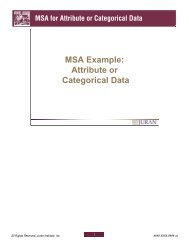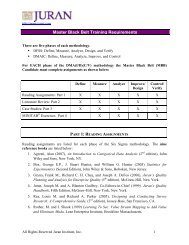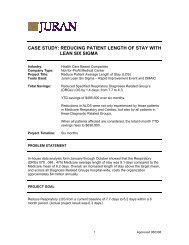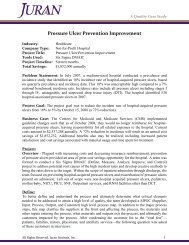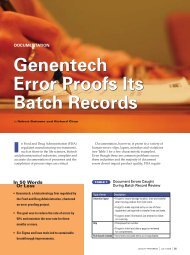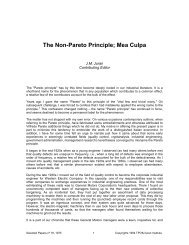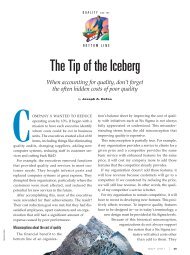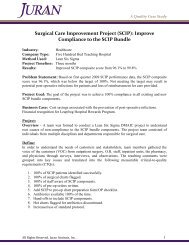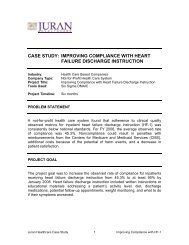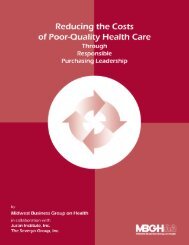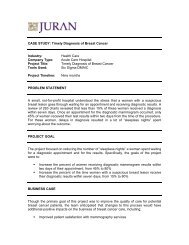Ch2 JAD Breakthrough and Beyond.pdf - Juran Institute
Ch2 JAD Breakthrough and Beyond.pdf - Juran Institute
Ch2 JAD Breakthrough and Beyond.pdf - Juran Institute
You also want an ePaper? Increase the reach of your titles
YUMPU automatically turns print PDFs into web optimized ePapers that Google loves.
20 CHAPTER Two<br />
THE BASIC TASK OF MANAGEMENT: THE JURAN TRILOGY 21<br />
the supplier <strong>and</strong> customer). All organizational <strong>and</strong> individual<br />
performance is dedicated to that end (or should be).<br />
• Products can be hard goods, services (work done for someone<br />
else), or information (data, software, etc.). Products are produced<br />
by means of processes.<br />
• A process is a sequence of tasks or events that creates an output-a<br />
product: goods, services, or information. Processes<br />
include everything involved in each step: people, techniques,<br />
software, machines, tools, raw materials, facilities, procedures,<br />
management practices, etc.<br />
• A customer is one who receives the output of a process or any<br />
step in the process. A client is a special kind of customer who<br />
pays for what is received. Customers do not necessarily pay,<br />
although they may. There are two basic types of customers:<br />
external (located outside of your organization) <strong>and</strong> internal<br />
(located within your organization). Each type of customer has<br />
needs that must be met if the organization is to serve its purpose.<br />
Usually, in a world-class organization, meeting the<br />
needs of internal customers is a prerequisite for being able to<br />
meet the needs of external customers. Management must<br />
devote its energy to meeting both sets of needs, with equal<br />
vigor <strong>and</strong> dedication.<br />
• A high-quality product is one that meets the needs of its customers<br />
at the lowest cost (minimum waste <strong>and</strong> maximum consistency).<br />
Quality is measured by determining the extent to<br />
which these two criteria are met. Observing the two possible<br />
characteristics of the outputs of a process-product features<br />
(good characteristics) <strong>and</strong> deficiencies (bad characteristics)<br />
makes this determination. It follows that the job of managers<br />
(leaders) is to produce high-quality products by putting in<br />
place all the necessary means to do this. The necessary means<br />
are described in the principles of the trilogy.<br />
• Process outputs can embody both product features <strong>and</strong> deficiencies.<br />
• Product features are the characteristics, or properties, of a<br />
product that meet specific needs of specific customers. For a<br />
person who purchases an automobile for personal use, the<br />
needs are the benefits sought from the automobile: transportation,<br />
style, status, <strong>and</strong> comfort. The associated product<br />
features are what specifically about the product meets each<br />
need. For the needs just listed, the product features may be a<br />
capacity of six passengers, power, top speed, acceleration,<br />
range, aerodynamic design, price, leather bucket seats, <strong>and</strong><br />
premier sound system. For a patient in a hospital, desired<br />
benefits (needs) may include quick admission, comfortable<br />
bed, <strong>and</strong> curing the ailment. The associated (service) features<br />
might be pre-admission by phone in advance of checking in,<br />
scientifically designed power-adjustable bed, <strong>and</strong> a recovery<br />
with no infection, no relapse, <strong>and</strong> no repeated treatment.<br />
Product features are what make the customer happy <strong>and</strong> give<br />
satisfaction. Product features are what produce sales <strong>and</strong><br />
repeat dem<strong>and</strong>.<br />
• Deficiencies are things that are wrong with the product-or<br />
the process. Examples of deficiencies are specific defects,<br />
excessive time cycles, <strong>and</strong> excessive costs. Defects include<br />
errors, omissions, the need for reworking or scrapping a product,<br />
etc. Defects make customers unhappy <strong>and</strong> produce dissatisfaction.<br />
Defects result in a loss of profitability because of<br />
the costs of poor quality (unnecessary waste) that eat into the<br />
bottom line <strong>and</strong> can reduce or prevent sales.<br />
NOTE: Satisfaction <strong>and</strong> dissatisfaction are not opposites.<br />
They are separate dimensions of customer<br />
reaction. Reducing dissatisfaction does not produce satisfaction;<br />
it merely reduces dissatisfaction. Increasing<br />
satisfaction does not decrease dissatisfaction; it merely<br />
increases satisfaction. Therefore, you cannot make customers<br />
who are dissatisfied by defects in your product<br />
less dissatisfied <strong>and</strong> happier by giving them more product<br />
features.<br />
For example, you can't make people happy with their unreliable<br />
cell phone service by granting them a large amount of<br />
free air time. They'll be pleased with the free time, but they'll<br />
still be unhappy with the lousy phone service.<br />
J



